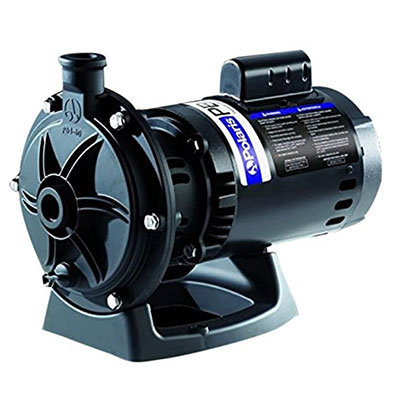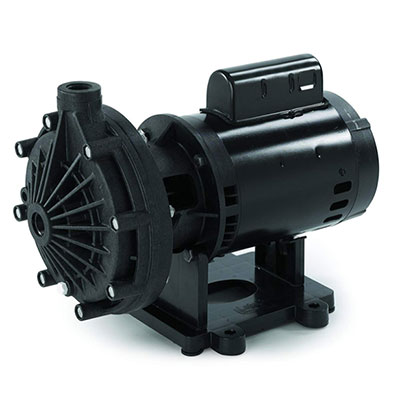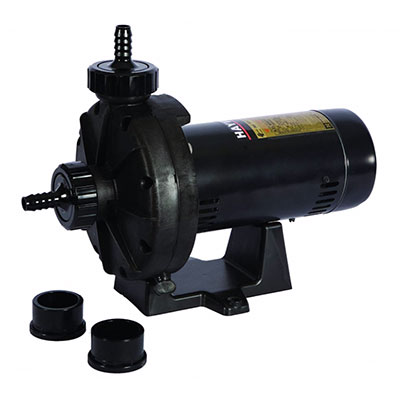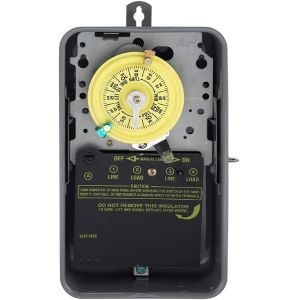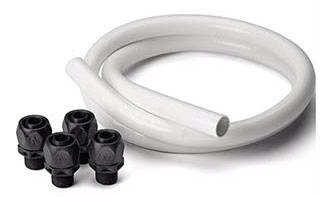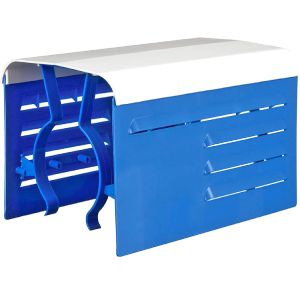- Salt Water Pool and Spa
- Pool Pumps
- Pool Booster Pumps
Pool Booster Pumps
A pool booster pump can provide an added boost of pressure to just about any existing pool system. Whether you need the extra pressure to improve your pool circulation or you want your pressure pool cleaner to operate at peak efficiency, there is a solution for you. It comes down to choosing the right booster pump based on a few variables that we'll discuss below. We'll also go over installation including plumbing and electrical requirements followed by our list of the top rated pool booster pumps on the market today.
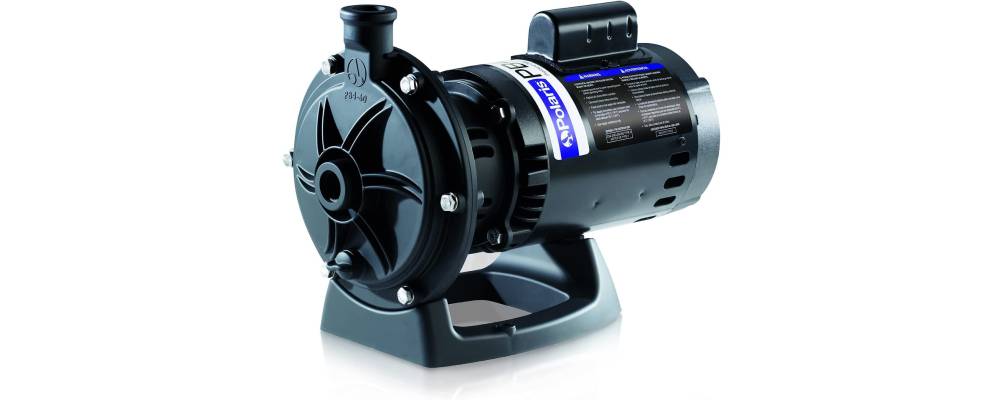
If you're just learning about pool booster pumps you've come to the right place. They are very similar to a regular pool pump and operate by pushing water through the plumbing to either increase circulation speed or provide an increase in pressure that's often required to operate a pressure side cleaner or robot pool cleaner. If you are adding a vacuum cleaner or you notice that your circulation is lacking, a pool booster pump can be very beneficial to your overall pool system, chemistry maintenance and chlorination if you own a salt water system.
What is a Pool Booster Pump used for?
It's important to choose a pump that is capable of supplying enough water pressure for the cleaner it will be powering. A pump that is underpowered will not provide enough pressure and either cause the cleaner to operate ineffectively or require longer running times, that can increase operating costs. An overpowered pump could damage the cleaner in extreme cases and increase electric energy consumption unnecessarily.
The most common reason you would require a pool booster pump is when adding a pressure side pool cleaner, usually a robotic cleaner. Pressure cleaners rely on water pressure to operate the vacuum and motor inside the cleaner unit. If you have a variable speed pool pump you may not require a booster pump to increase flow rate because you can increase pump pressure during cleaning times by using a pool pump timer or automation control panel. (see electrical requirements below)
If you suspect that your pool circulation system is not up to par because you are constantly experiencing cloudy water, poor filtration or decreased chlorination you may need to add a pool booster pump or switch to a variable speed pump. A pool service technician will troubleshoot issues by calculating the total dynamic head or TDH of the pool system. The bottom line is that there might not be enough pressure, and occasionaly it can mean there is too much pressure.
Benefits of Using a Pool Booster Pump
In addition to maximizing the effectiveness of a pressure side pool cleaner, a pool booster pump is an affordable and easy way to increase the overall health of your pool and even reduce operating costs. A booster pump can lead to improved filtration quality, more consistent heating and more efficient chlorine production through increased circulation. It gives you the option of increasing water pressure when needed and allows you to get the most out of added features like waterfalls or water features.
Top Rated Pool Booster Pumps
The best pool booster pumps make our top rated list for a few reasons including pricing, quality and customer satisfaction. Purchasing a booster pump from a reputable brand gives you peace of mind and exceptional brand performance you can count on. Every pump on this list is energy efficient, quiet and has a very high user review rating. If you are considering purchasing a pressure pool cleaner for your inground pool you will be happy with how all of these pumps perform.
Polaris PB4-60 OEM Pool Booster Pump
The Polaris PB4-60 OEM Pool Booster Pump for pressure pool cleaners is at the top of our list for it's quiet and reliable operation while bringing industry leading performance. You can count on your cleaner working at maximum efficiency while meeting todays energy guidelines. This top rated pool booster pump is easy to install and is backed by Polaris customer satisfaction and support network.
Pentair LA01N Pool Booster Pump
The Pentair LA01N Pool Booster Pump is an energy efficient unit designed to operate any pressure-side pool cleaner. This universal pump will help keep your pool clean with a 3/4 horsepower motor that provides 50 PSI at 12 GPM for a ton of cleaning power. It comes with connector hose and adapters so you can count on seamless installation into your existing pool system and plumbing.
Hayward 6060 Pool Booster Pump
The Hayward 6060 Pool Booster Pump is the most energy efficient option when it comes to the top rated pool booster pumps available on Amazon. You can count on using up to 40% less energy compared to other brands of pumps on the market. It's suitable for use with all types of pressure pool cleaners. Pump comes with hose adapters for easy installation into any existing plumbing system.
Pool Booster Pump Installation
Installing a pool booster pump on your own should only be considered if you are a handy pool owner or a qualified service technician. It's common for manufacturer's to void or not honor warranties if the pump wasn't installed by a professional. If you do decide to install it yourself be sure to read through the following information including instructions about winterizing. a pool booster pump.
Electrical Requirements
The majority of pool booster pumps come factory set to operate on 240 volts but they can be switched to 120 volts if it's more convenient. Instructions for this can be found in the operators manual or on the pump itself. The operation of the pump should be set up to run through a pool pump timer, time clock or control panel.
The booster pump on/off function should be set to turn the booster pump on at least 30 minutes after the main pump is turned on, and at least 30 minutes before the main pump is turned off. This synchronization ensures that the booster pump is not operating when the main pump is not operating. If you operate the booster pump without the main pump turned on, you can cause damage to the booster pump.
Intermatic Pool Booster Pump 24 Hour Switch TimerIf you click on this link and make a purchase, we may earn a commission. |
Plumbing Requirements
Most pool booster pumps require a dedicated return line and should be plumbed into the system so that they are always receiving flow from the main pump. Synchronize the booster and main pump with a pool pump timer as mentioned above. The basic pool booster pump plumbing diagram below should be followed to ensure proper operation of the pump and pressure cleaner.
- Plumb the booster pump line upstream from all air inducing equipment; pump, filter and heater.
- If the system has a heater, splice the booster pump inlet at 3 feet downstream from the heater discharge. Avoid the 3 foot section of heat sink pipe adjacent to the heater.
- If you are using a solar system that diverts all water flow to fill the panels, install an automatic override to shut the booster pump off during solar heater water transfer.
- Install the pump higher in elevation, upstream and as far away as possible from the chlorine generator.
 Basic Pool Booster Pump Plumbing Diagram
Basic Pool Booster Pump Plumbing DiagramPool Booster Pump Flow Rate
The pool booster pump flow rate is important to maximizing the cleaning power and efficiency of the vacuum cleaner. These guidelines will help ensure that you get the best flow from the booster pump and prevent damage to the pump itself.
- Use rigid PVC plumbing with a minimum diameter of 3/4" - 1 1/2" for the return line. The inlet line should be at least 3/4". Flexible PVC pipe is not recommended because it can expand and contract during surges.
- Try to minimize resistance to flow by using angled elbows and minimizing bends or loops.
Installing the Pump
Securing the booster pump is essential to proper operation and to make sure it doesn't damage the plumbing during water surges. The pool booster pump installation kit should include screws for anchoring to concrete or a solid and sturdy surface. The pump will also come with connectors and a flexible hose for easy installation using room temperature vulcanizing (RTV) silicone sealant. Always refer to your pump manufacturers instructions for installation of hardware.
Winterizing a Pool Booster Pump
A pool booster pump needs to be winterized if you live where temperatures drop below freezing for any length of time. This is necessary to prevent freeze damage to the internal parts of the pump as well as adjacent PVC plumbing due to frost expansion.
- Pull out the drain plug and make sure that all water is drained from inside the pump either by leaving it exposed to the air or using a shop vac to blow the air out.
- Disconnect the plumbing connections to the inlet and outlet ports.
After temperatures warm up to where there is no threat of freezing, trim the hoses to eliminate inconsistencies that can cause blockages. Find more information about pool closing over winter including water treatments and hardware preparation.
Pool Booster Pump Covers
A pool booster pump cover is a cheap way to protect your investment especially if you live in a climate that experiences lots of rain or snow in the winter. While most booster pumps are designed to operate outdoors and withstand all types of weather including rain, we still recommend using a cover to prolong the life of your pump. If you don't have a pool shed and the pump is installed outdoors a cover is an easy solution.
The air vents on some booster pumps can be susceptible to taking on water from rain, splash out or a nearby sprinkler.
Pool Booster Pump Cover Shed
If you have an existing pool shed and there is enough room to install the booster pump while providing adequate ventilation that is a great option. It allows you to keep the pool booster pump and your other pool equipment protected year round. A pool pump shed is highly recommended especially since they are very affordable and increase the safety of your pool environment.
Blue Devil Adjustable Pool Booster Pump Motor CoverIf you click on this link and make a purchase, we may earn a commission. |
Pool Booster Pump Troubleshooting
If you already own a booster pump and are having problems with it, we've made a comprehensive list of possible problems you might have with your pool booster pump. If you are experiencing problems call a licensed and qualified pool service professional to perform diagnostics and repairs. There are however some checks any handy pool owner can perform to eliminate an easy-to-fix problem.
Pump not working
- Check that the pump is plugged into the appropriate supply voltage outlet. If the pump is wired for 115VAC and the supply voltage is 230VAC it might not work and could also be damaging the motor.
- Use a digital multimeter to ensure that the power supplied is within 10% of the nameplate voltage.
- Check the capacitor to see if it is bad and needs replacing.
- Insert a 1/4" hex key into the center of the drive shaft in the fan cover opening. If the drive shaft doesn't spin easily, it may be seized and need replacing.
Cleaner not working
- Check to make sure that all valves are in the proper positions.
- Clean the skimmer baskets, pump basket and filter if necessary.
- Ensure that the cleaner is properly set in accordance with the operators manual.
- The pump might not be powerful enough to operate multiple pieces of pool equipment at the same time; water features, waterfall, hot tub, etc. If this is the case you will need to program the features to operate separately, increase power from the pump if its variable speed or purchase a larger horsepower pool booster pump.
Bubbles in the filter pump basket
If you have bubbles in the filter pump basket make sure that the water levels is high enough so that air isn't being drawn into the plumbing system. If the water level is ok, turn off the pump, remove the lid and check for anything blocking the lid o-ring and seal. If there is any debris clean it thoroughly and replace the lid by hand-tightening. The seal should be tight and free of debris so no air is drawn into the plumbing.
- Check the suction side plumbing connections while the pump is running and tighten if necessary.
- Ensure that all connections are secure and tight, creating an air-tight seal. You may need to use pliers to gently tighten the unions.
Pressure drops or fluctuates
- Check the pump impeller for signs of wear and replace if necessary.
- Check to make sure the o-ring is properly installed and isn't damaged.
- Check the pump seal to make sure it isn't leaking air. If you can hear air, have a qualified service technician replace the seal.
- If the installation is relatively new it may be an issue with the electrical connection. Make sure that the voltage is within 10% of the pool booster pumps date plate rating. If not, have an electrician service the pump.
Pump is leaking
- If the pump is leaking between the motor and pump body it's most likely a faulty mechanical seal which needs to be replaced.
Overheats and shuts off occasionally
- Make sure that there is adequate air ventilation to keep the pump cool during operation.
- Check to make sure the pump is receiving the proper voltage.
Loud noises
- Check to make sure that there are no leaks, blockages or debris on or in the pump.
- If the pump is loud when it's operating and accompanied with any of the other issues listed above, troubleshoot accordingly. Pool booster pumps do have a shelf life and it's possible it may be worn out through regular wear and needs to be replaced.
Disclaimer
Please use all appropriate and proper safety precautions when attempting projects on this website. All projects are attempted at the reader's own risk.
Salt Water Pool and Spa™ participates in the Amazon Services LLC Associates Program, as an Amazon Associate we may earn a commission from qualifying purchases.
